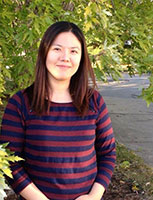I wear several different hats. I am a professional in the field of special education and a mother raising a bilingual child. I am still an English language learner since coming to the United States 11 years ago. What I would like to share with you now is about the hat I love the most, being the mother of a dual language learner (DLL), Joshua, who started kindergarten this year. I will talk about his birth to very early years here and share my experiences with his later years in the next blog.
Words deliver emotion
During my pregnancy, my husband and I tried our best to talk to Joshua just like many other parents. We continued reading books to him and singing different songs for him after he was born. And we did all these in our native language, Korean. We both came to the United States as students a long time ago and speak English fine, but neither of us even thought about speaking in English during those intimate moments with baby Joshua. English did not feel natural when building such an intimate relationship with our baby. We called Joshua by his Korean name (Joshua’s middle name is his Korean name, Seojin). We said, “I love you” to him in Korean. Even now, when I say, “I love you,” I say it in Korean, and I prefer that Joshua calls me “um-ma” instead of the English word “Mom.” When we say those words in Korean, I feel that the words reach to the very bottom of my heart.
Entering day care with limited English
When Joshua turned 2, we decided to send him to day care. Suddenly, I got so nervous with the fact that he knows only a few words in English. How can he ask for help? How can he let the teachers know when he feels sad? What should he do when he wets his diaper? Can he even understand what all the other people say at school? Full of worry, I started using English at home. I used simple phrases such as “Come here,” “Sit down,” “Look,” “Do you feel sad?” and “What do you need?” I also started calling him by his English name. I think I made the right decision, and it helped ease his transition to day care.
Every parent worries when their child starts school for the first time, but the worry is doubled for parents of DLL students because their children have rarely been exposed to English before. And most parents do not know the words or phrases that are often used in a school setting. (If the school provides a list of words or phrases that parents can use at home before school starts or at the beginning of the school year, it will be beneficial for teachers, parents, and children.)
I am very grateful that Joshua’s first day care teacher was willing to learn some Korean words from me and use them with Joshua. She asked me how to say, “Mom is coming” and “Do you need a hug?” in Korean and used them whenever Joshua was sad. I could definitely tell these soothed him well. Teachers can learn some words from parents of DLLs and use them often to help these children feel more comfortable at school.
A picture is worth a thousand words
After a month or two, Joshua was not crying anymore. He liked being in day care and learned many new things. One thing I noticed, however, was that he did not seem to understand everything that the teacher said. He often looked at what other children were doing after the teacher gave a verbal direction and then did what the others did. During center time, he sometimes did not understand the details for an activity and only completed half of it correctly. He could not answer the higher-level thought-provoking questions because he did not fully understand the question itself or did not have enough English fluency to respond.
Teachers tend to explain what to do, how to complete a task, and what a new word means only by using words. For many children, this explanation is good enough, but for DLL students, additional visual supports are often necessary. If the teacher explains the learning center activity by showing a completed product and provides a photo or other visual example, all children will have a clearer understanding of how to complete the activity. For example, if the teacher shows a picture of a caterpillar when explaining what a caterpillar is, all of the children will benefit from viewing a picture when discussing a new word.

Hyejin Park
Dr. Hyejin Park is an alumna of the department of special education at the University of Illinois at Urbana-Champaign. She has a master’s degree in teaching English to speakers of other languages (TESOL) and received her Ph.D. in special education. Hyejin also taught children with disabilities in public schools and is the mother of a boy who speaks both Korean and English.
Biography current as of 2022


